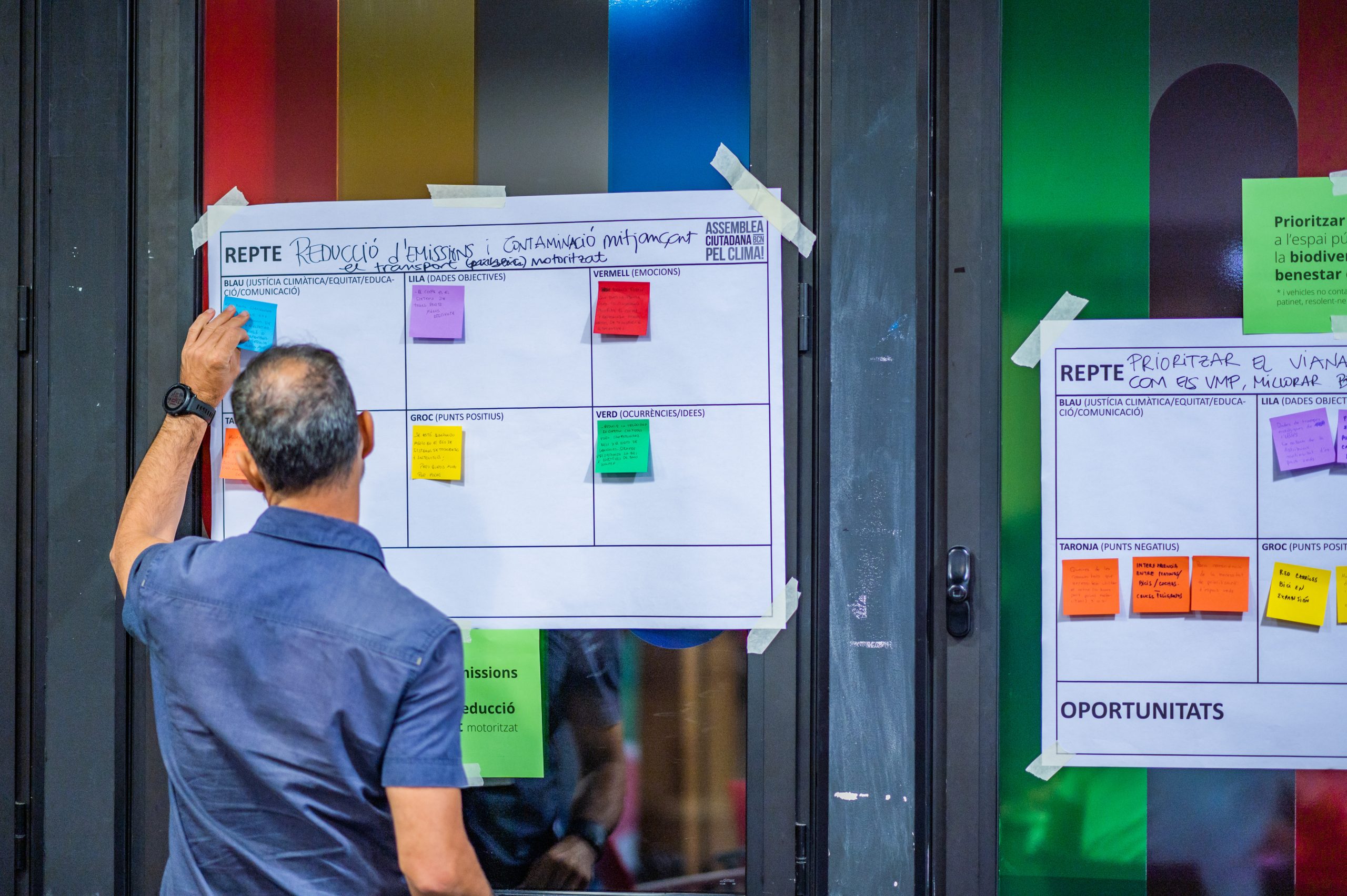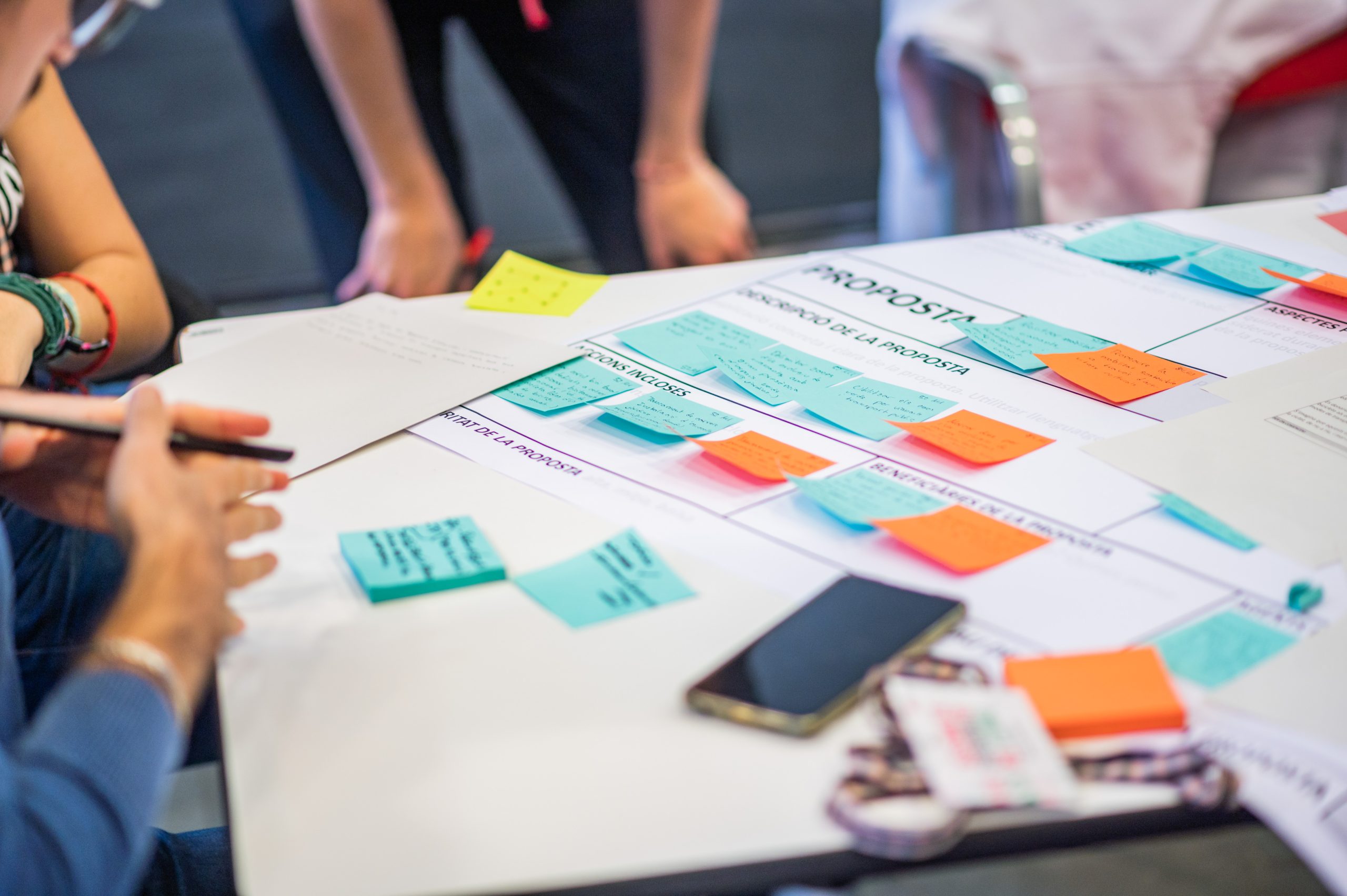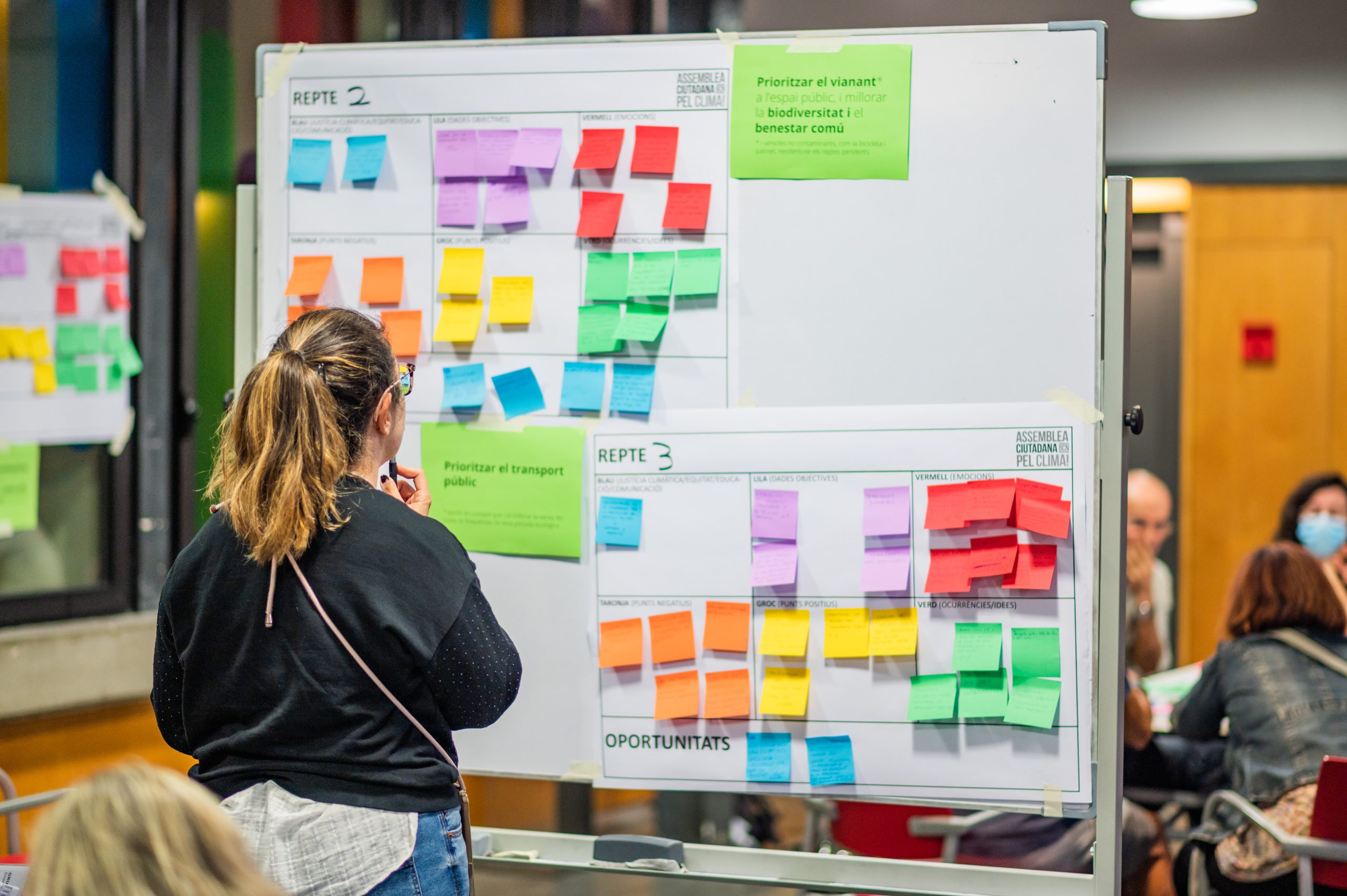The Barcelona Climate Assembly, run by the city council, involved citizens in the decision-making process regarding climate change policies. The assembly was composed of randomly selected citizens who participated in a series of meetings and discussions, and produced a comprehensive set of recommendations for the city council, made accessible to the public. The fate of these recommendations now lies in the hands of the incoming government, which will decide how many of them to adopt. In this interview with Gerard Lillo Jové, Head of Department of Urban Participation at Barcelona City Council, you will learn about the journey to establish the Barcelona Citizen Climate Assembly, the process of recruiting participants, how the process ensured inclusivity, and the challenges and lessons learned in the process.
Why did the participatory process begin?
In Spain, particularly in Catalonia and Barcelona, there has been a growing emphasis on involving citizens in addressing climate change through climate assemblies. In 2021 and 2022, the Spanish government initiated a climate assembly, while the city council of Barcelona conducted its own assembly in 2022. Now, the regional government of La Segla de Catalunya is also gearing up to organise a climate assembly, set to begin in October or November. These initiatives aim to engage citizens in the decision-making process regarding climate change policies.
What is the maturity of deliberative democracy in Barcelona?
While several local governments in Spain are adopting this approach, it’s important to note that there is no existing law that governs such participation models. As a result, the Catalan government is in the process of developing a new law on participation. During this process, there was a consultation that included requests from Barcelona and other municipalities to incorporate citizen assemblies as a legitimate participation mechanism.

Despite the fact that the specifics of the law are yet to be confirmed, as the legislation is still in the drafting, the underlying motivation for starting these climate assemblies in Barcelona, apart from addressing climate concerns, is rooted in a desire to foster greater citizen participation and innovation in the decision-making process. Barcelona aims to be at the forefront of cities in Spain in promoting such citizens’ assemblies, fostering collaboration between government and citizens to shape policies for combating climate change.
What were your sources of funding, and how much did you invest?
In funding the Barcelona climate assembly, the financial resources were primarily derived from public funds provided by the city council. Approximately €150,000 were allocated for the assembly, a significant investment reflecting the importance and scope of the event.
Importantly, participants of the assembly were compensated with approximately €9 to €10 per hour, recognising the value of their time and contributions. This compensation was factored into the total budget allocated for the assembly, ensuring that participants’ financial concerns were addressed. It played a pivotal role in sustaining participation throughout the entire assembly process, reinforcing the commitment of those involved.
The budget also covered an array of services, as mentioned earlier. Notably, the costs related to civil servants were not included in this budget, as internal resources were allocated to various projects simultaneously, making it challenging to attribute specific costs solely to the assembly.

Key expenses within the budget included costs for external facilitation, the assembly’s physical location, and video streaming services, which were essential for ensuring that the assembly’s proceedings were accessible and transparent to the public. The comprehensive budget was essential to support the assembly’s objectives and ensure that it operated effectively in addressing the pressing issues of climate change and sustainability in Barcelona.
How did you recruit the participants? To what extent was the participatory process inclusive, making sure marginalised or vulnerable groups were included?
The preparations kicked off in April 2022, and after months of careful planning, participant recruitment started in June and July of 2022. It began with the distribution of letters to 20,000 randomly chosen city inhabitants. The response rate from this outreach was modest, averaging around 6 to 7 percent, which equated to approximately 1,500 individuals expressing interest in taking part in the assembly. However, the timing was less than ideal, with the letters coinciding with the summer holiday season, and not everyone received them. This posed a challenge, especially for people who were away on vacation.

Out of these initial respondents, 100 assembly members were ultimately chosen to participate. However, this selection wasn’t a straightforward process. To ensure diversity and representation, a second lottery was conducted, taking into account those who had shown their interest. The lottery retained the initial criteria of gender, district, and place of birth, making sure that the assembly reflected the varied demographic makeup of the city.
The process of selecting participants for the Barcelona climate assembly was a dynamic and adaptive one, aiming to include diverse voices and perspectives in addressing the city’s climate challenges. Importantly, the process of engagement and interaction with participants extended to a digital platform. When the letters were initially sent to prospective participants, those interested were directed to check the platform and complete a form to express their willingness to join the assembly. This initial step was crucial for building a diverse and representative group of participants.
Yet, the organisers recognised the need for improvements in the selection process, especially in cases where people did not reside at their registered addresses or had different cultural backgrounds. While the lottery system was employed for selection, the organisers recognised that improvements were essential for future assemblies. It became evident that the process didn’t guarantee invitations to minority groups and didn’t ensure their adequate representation. For example, it was noted that people with physical disabilities were notably absent from the assembly, raising questions about either their non-invitation or non-selection through the lottery.

Determining the economic characteristics of the participants was not a primary selection criterion. Directly asking about economic factors was considered challenging and sensitive. Instead, the assembly participants were selected based on their district of residence, with the assumption that this indirectly represented their socioeconomic backgrounds. While it encountered challenges, the organisers were committed to refining the process for future assemblies to ensure even greater inclusivity and representation.
How did the participatory process develop?
The journey to establish the Barcelona climate assembly embarked on a meticulous and time-consuming endeavour, driven by the vision to actively involve citizens in shaping the city’s response to climate change.

In September 2022, the assembly unfolded over several months, concluding in January of the following year. It commenced with three sessions, each spanning approximately 10 hours, dedicated to building the initial skills of participants and shaping the assembly’s agenda. In defining its agenda and topics, the Barcelona climate assembly posed open-ended questions to encourage a wide range of perspectives. Early discussions centred around climate change, with participants selecting three topics – energy, mobility and waste management – from a list of ten during initial sessions, shaping subsequent discussions and highlighting the assembly’s participatory nature. Subsequently, six deliberation sessions, each lasting around 21 hours, became the crucial in shaping the assembly’s recommendations.
A distinctive aspect of the assembly was a three-hour visit to a waste disposal centre, providing participants with valuable insights into waste management and its environmental impact. During a four-hour session, participants presented proposals and cast votes on recommendations.
Also throughout the assembly’s progress, the digital platform Decidim played a vital role. It included a public area featuring a blog that detailed the assembly’s proceedings session by session, providing participants and the public with insights into what was happening. Additionally, there was a dedicated online space for participants, offering them a variety of resources and information. This included video recordings of conferences, links to materials and lectures, and access to recommendations pertaining to the assembly’s topics. There were also spaces for general discussions related to the assembly’s themes, as well as specific sections for each of the three selected topics.

The final stage involved a crucial presentation to the mayor and political parties of the City Council, ensuring that the insights of assembly members resonated with the city’s leadership. Recognising the complexity and potential impact of the assembly, a monitoring committee was established, comprising civil servants, political parties, city organisations, a sustainability and climate change organisation, and five assembly members. This diverse committee aimed to facilitate improvements between assembly sessions and garner support from all political parties.
The intricate planning revealed a lack of internal resources within the city council for effective facilitation. To address this, collaboration with Raons, an external organisation experienced in facilitating gatherings, was initiated. Raons brought a team of 12 individuals, including coordinators and facilitators, playing a pivotal role in orchestrating assembly activities and guiding participants through diverse session types.
The assembly featured a variety of session formats to cater to participants’ diverse needs, including plenary sessions, specific groups, and ten separate teams, each with a dedicated facilitator. Raons’ expertise was indispensable in managing the intricate array of activities, ensuring a smooth execution, and amplifying the voices of every participant in shaping Barcelona’s response to climate change.
The collaborative effort extended to the monitoring committee, which played a vital role in overseeing the assembly’s various phases. Comprising civil servants, political party representatives, citizen organisations, and climate-focused groups, the committee held five strategically placed meetings throughout the assembly process. Notably, the initial meeting, held in June or July, excluded assembly participants, emphasising the dynamic nature of the committee.

The committee’s multifaceted role included offering advice, checking assembly steps, validating methodologies, and ensuring a high standard of inclusivity and responsiveness to the city’s needs. External climate change experts enriched the committee’s insights, providing expertise and contributing to the assembly’s proceedings.
While initially tasked with overseeing proposal implementation, the committee clarified its role to also follow the progress of recommendations, especially in the absence of government feedback. The estimated duration of the monitoring committee’s role was two years, with the expectation that the assembly’s proposals and recommendations would lead to tangible outcomes in Barcelona’s efforts to address climate change and sustainability.
In the Barcelona Climate Assembly, an independent journalist played a crucial role in supporting the participants throughout the process. This journalist not only provided valuable guidance on how to write effective recommendations but also took on the responsibility of finalising the written recommendations. Their expertise was instrumental in refining the participants’ suggestions and ensuring they were well-structured and impactful. Furthermore, the journalist offered valuable advice on how to present these recommendations to the mayor and the political parties of the city council. They also coached the participants on handling media interactions, helping them feel more comfortable in interviews and anticipate potential questions from the media. Its role was highly appreciated by the participants, and they considered this external support to be instrumental in the assembly’s success.
What were the outcomes and lessons learned of the participatory process?
The assembly generated a total of 36 recommendations, of which 34 were ultimately accepted. These recommendations were meticulously assessed by the technical team, analysing each one and providing a proposal regarding their acceptance or potential modifications. It was recognised that not all recommendations could be entirely accepted; some might require adjustments or could be partially accepted. The government was tasked with explaining which recommendations were accepted, which were not, and the rationale behind these decisions. This feedback process was essential to maintain transparency and ensure participants understood the outcomes.
The government’s decisions and explanations were not only conveyed through meetings with participants but also documented in official reports and publications. This comprehensive approach aimed to ensure that the assembly’s outcomes were transparent, accessible, and well-documented.

However, the fate of these recommendations lies in the hands of the incoming government of the city council, which will decide how many of them to adopt. The assembly’s progress and outcomes will be presented in a meeting of the monitoring committee and subsequently in an open session, allowing all participants to witness the government’s response. This marks the crucial next step in implementing the recommendations and translating the assembly’s discussions into tangible actions.
What challenges did you encounter?
The Barcelona climate assembly encountered challenges, notably in timing, due to concerns about local elections affecting the government’s response to recommendations. Additionally, to tackle the underrepresentation of minority groups, organisers considered various methods for participant invitations, including personal visits, internet-based communication, and phone calls, though this did not ensure a balanced and diverse representation.
However, logistical challenges arose as topics were determined post-initial sessions, complicating efficient assembly organisation. Despite the positive aspect of allowing participants to choose topics, organisers contemplated making the question more specific for future assemblies, possibly limiting the selection to one or two topics for better logistical management and focused exploration.
The assembly also faced challenges adapting methodologies for participants unaccustomed to such processes. Deliberative sessions felt rushed, prompting a re-evaluation and potential extension of allocated time. Private platform spaces intended for discussions were underutilised, emphasising the effectiveness of more direct channels like email, phone, WhatsApp, and Telegram for communication.
Participant commitment primarily centred around physical sessions, with engagement between sessions proving more challenging. Recognising varying participant activity levels, organisers emphasised the importance of flexibility and multiple participation modes to accommodate diverse engagement levels and contributions. This insight highlighted the need to balance expectations and cater to different participant preferences.
What are the elements that could be transferred to other contexts? What are the conditions of a successful transfer?
A key recommendation arising from the Barcelona climate assembly’s experience was the significance of timing. It was evident that the assembly should not be close to elections either to avoid any potential interference from political campaign dynamics, but also to have the right time for the preparation and a continuum with the administration. The organisers recognised that the government promoting the assembly should have sufficient time to act on the recommendations. A period of one to two years was considered reasonable for the government to ensure the implementation of accepted proposals. Furthermore, a minimum of six months was deemed necessary for the proper preparation and execution of the assembly. Also, fundamental allocation of time for the deliberative phase.
The assembly underlined the significance of post-assembly engagement, specifically in terms of monitoring and implementing the recommendations. It was vital to sustain support for participants beyond the assembly’s conclusion and facilitate ongoing interactions to address their questions and concerns.
Additionally, financial resources were crucial for the assembly’s success. A significant budget was required to cover expenses such as facilitation, location, video streaming, and other services. Securing government commitment for these resources and involving various administration departments connected to the assembly’s topics, such as mobility, green spaces, and public space design, was crucial.
Conclusion
The case of the Barcelona climate assembly is a promising example of citizen engagement in the decision-making process regarding climate change policies. Despite the fact the organisers attempted to enhance inclusivity by considering various methods for participant invitations and deliberation throughout the process, the assembly faced challenges, including timing and underrepresentation of certain groups, such as people with physical disabilities or minorities.
Another potential limitation of the assembly is that the fate of its recommendations lies in the hands of the incoming government, which may or may not adopt them. This raises questions about the effectiveness of citizen engagement in decision-making processes if their recommendations are not ultimately implemented.
This case study can be found in The Toolbox of Experimental Participatory Methods, produced in the Horizon2020 EUARENAS project.

